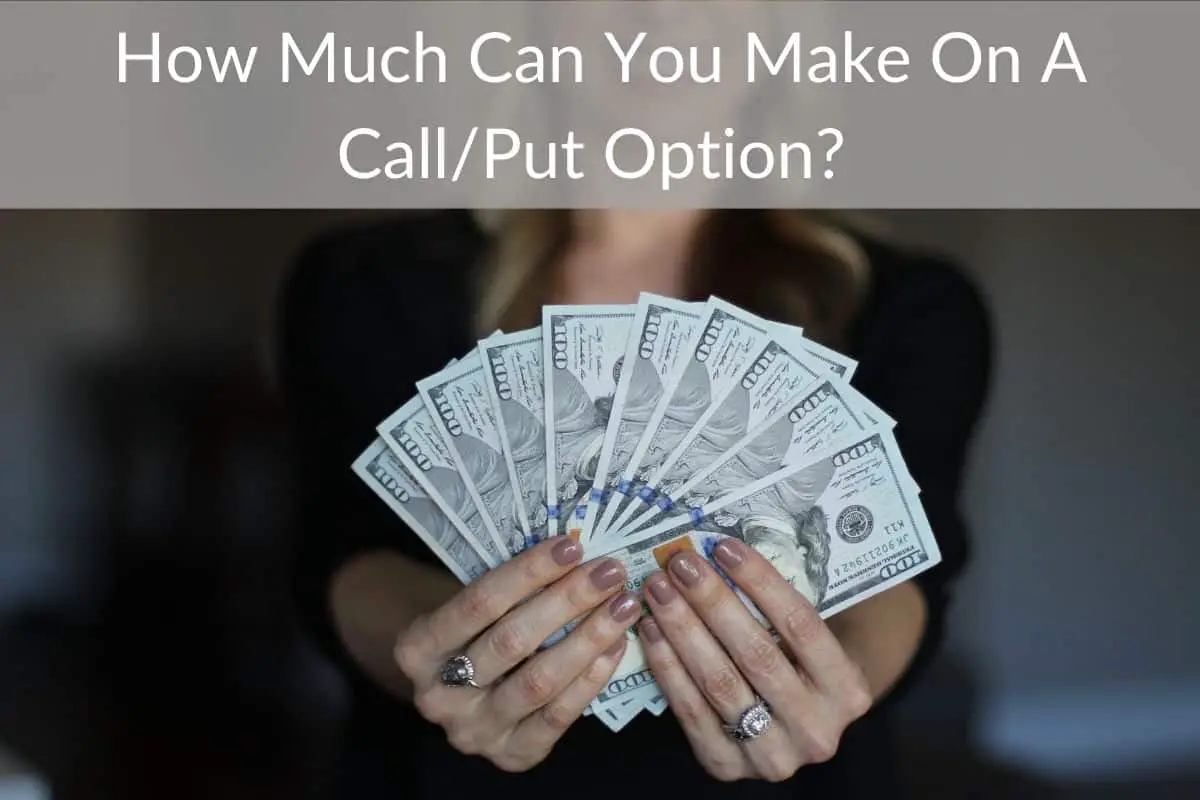Table of Contents
*This post may contain affiliate links. As an Amazon Associate we earn from qualifying purchases.
If you’re thinking about becoming an options trader, one of the first questions you might have will probably revolve around how much you can make per call or put option. With the answer, you can start computing projected monthly or yearly income.
Exactly how much can you make on a call or put?
You can actually make unlimited money when you buy a call option. The maximum that you can make on a put option is the strike price times the number of contracts (if it goes to zero).
For all other options trading positions, the earnings are more limited.
As a put buyer, your income is the value of an in-the-money contract minus the premium price. As a call/put option seller, your maximum gain is the premium received.
Let’s say for example you buy a $10 call on stock ABC. If that stock goes to $5,000 a share before your call expires you will be able to buy it (per the options contract) for $10 a share still. So your profit would be $4,990 per share times 100 shares (since options are in 100 share lots).
Your profit in this hypothetical scenario would be 499,000 on that single call option (minus the premium paid to purchase the option).
Now let’s look at buying a put.
The profit isn’t unlimited when buying a put since a stock can only go to zero. So let’s say that you bought a put option on XYZ stock that is currently at $100 a share.
If the stock goes to zero you will make $100 per share (minus your premium that you paid for the put option). Again these are sold in 100 lot shares so you would have a $10,000 profit on a single put option.
In real life a stock rarely goes from $100 to zero (especially before a put option’s expiration) and a stock rarely goes from $10 to $5,000 (again before the option will expire) however I hope these examples help you understand the profit potential of buying puts and calls a little bit better.
In the rest of this article, I will go into more detail about the intricacies of options profitability. I will also look at some of the risk and reward possibilities for the main options strategies.
How Options Traders Make Profits on Positions
A call option buyer will only make a profit if the underlying stock rises above the designated strike price before the expiry of the option.
On the other hand, the put option buyer will make a profit if the price falls below the strike before the expiration. The profit for both traders will come down to the difference between the stock price and the contract strike price at expiration (or when they sell the call/put on the open market).
A call option writer (option seller) will make a profit if the underlying stock remains below the strike price until expiry, while the put option writer will make a profit if the price stays above the strike price.
The profit is limited to the premium paid by call or put buyers for their contracts.
Option buyers can make outsized returns on their investment if a trade goes in their favor because the stock price can move significantly beyond the strike price. For a call buyer, the movement isn’t capped by anything other than time (the time until expiry).
The stock can move up past the strike price and continue climbing indefinitely. It’s similar for the put buyer, but the stock can only fall to zero.
Option writers make smaller returns overall if the option trade is profitable because their profit is capped at the premium buyers paid and what they agreed to buy or sell the stock at regardless of how much further the stock moves.
You may be wondering why options traders bother to write options if the profits are capped.
The answer is that options writers are more likely to close a trade in profit. The odds are significantly in their favor. According to a Chicago Mercantile Exchange (CME) study, 75% of all options held to expiration expire worthless.
The study doesn’t account for options that were exercised or closed out before expiry.
However, the fact that seven in ten contracts that reach the expiration date are out of the money shines more light on why option writers are more likely to make a consistent profit.
How To Decide if You Should Be an Option Writer or Buyer
To decide which side of the divide you should favor, you should take time out to calculate your risk tolerance. Here’s an example to help you with that.
Let’s assume you’re choosing between buying or writing 20 call option contracts with the price of each at $1. Since an option contract typically has 100 shares of the stock, 20 contracts would cost you $2,000 ($1 x 100 x 20 contracts).
If you choose to buy ten call option contracts, you’ll pay $2,000 as the premium. If the trade doesn’t go in your favor, you can only lose $2,000. However, if it goes in your favor, there’s no limit to your profit.
Returns of more than 500% on a singular trade are common for volatile stocks.
Unfortunately, the probability of the stock rising above the documented strike price is low. Going by that study above, it’s 25% barring the impact of external factors, such as sudden announcements.
If you go the other way and write ten call options contracts, your maximum profit is the $2,000 premium you’ll receive from the buyer. Your potential loss is higher as you have to hold the stock (if selling a call) or have the cash in hand to buy it (if you sell the put), but the odds of the trade going in your favor are as high as 75%.
Looking at both scenarios, you can look at your risk tolerance to help you figure out which one you will go with.
Do you prefer the chance of making a capped profit 75% of the time with a 25% chance of a loss, or would you rather risk losing your investment 75% of the time but have a chance of making outsized profits 25% of the time?
Keep in mind that there’s no right or wrong answer to this.
It’s a personal decision you have to make, in line with your trading strategy. With a 25% chance of success, many options buyers post respectable returns at the end of the year. Some experts recommend sitting on the fence and buying or writing depending on what your strategy dictates at that time.
It’s common to find traders that are buyers for a specific asset and writers for another. Such a combination of strategies can significantly change the odds in your favor.
You should also keep in mind that call buying is only low risk if the premium you’ve exposed to the market is a fraction of your trading capital. In the example above, $2,000 should never be the total money in your trading account.
The exact fraction of risk varies from one trader to another. However, experts typically recommend risking less than 5% of the account on any single position.
How To Get Started As An Option Buyer Or Seller
The first step is to find an options trading broker that appeals to you.
A quick search online should show you some of the best brokers you can work with. Go through their requirements and choose any of them that work best for you.
For example, some brokers have minimum funding requirements. Others have different rules on how you can manage your positions. If you intend to switch between buying and writing calls, you must confirm that it’s allowed on that same account.
Don’t forget to confirm the rules surrounding the contract expiry.
Final Thoughts
The profit on a call option is unlimited for a buyer. It can go as high as 3-4 digit percentage points in some rare cases. However, there’s a limit on the profit you can theoretically make for all other types of options.
Conversely, losses are limited to the premium for call and put buyers, while it can be much higher for writers (sellers) as they either have to hold the stock (if selling a call) or be willing to buy a stock at a predetermined price (if selling a put).
Options traders can improve their odds of making a consistent income by switching between buying and writing calls as the market demands.

